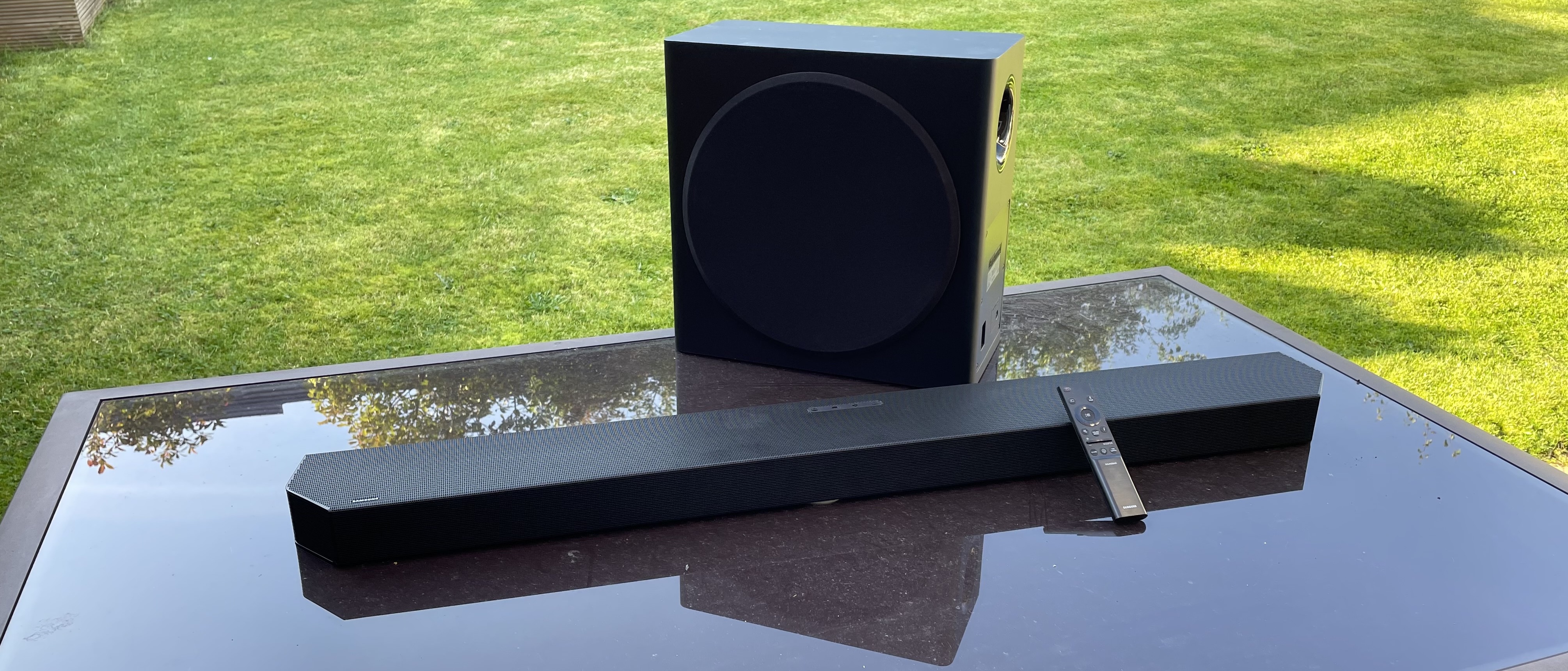TechRadar Verdict
Don’t be fooled by the Samsung HW-Q800C’s unassuming looks. Inside that all that angular grey plastic resides a phenomenally powerful multi-channel speaker system capable of unlocking the joys of a good movie soundtrack more effectively than arguably any other soundbar in its class. Plus you can add optional rears if you want to crank up the immersion even more
Pros
- +
Phenomenal power and projection
- +
Can be upgraded for full surround
- +
Aggressively priced for what it offers
Cons
- -
No 4K/120Hz HDMI passthrough
- -
Not as musical as some rivals
- -
Not the prettiest soundbar around
Why you can trust TechRadar
Samsung HW-Q800B: Two-minute review
The Samsung HW-Q800C is the company's premium "convenience" soundbar from 2023, meaning that while it dispenses with the rear speakers and some of the size and power you get with Samsung’s flagship Q990C soundbar, its "bar-plus-subwoofer" package still offers more power and real channels – it claims 5.1.2 – than the majority of rival soundbars hovering around its official £749 / $699 / AU$799 price.
The Samsung HW-Q800C supports Dolby Atmos and DTS:X, with two upfiring drivers to deliver the height channels. There's also support for a wide range of music files, including high-resolution ones such as FLAC.
There’s an HDMI passthrough system for anyone concerned about losing one of their HDMI ports to the TV, and if you use the soundbar with a recent Samsung TV you can also get the speakers of each device to join forces into an ever bigger sound, using Samsung's Q-Symphony tech.
In action, the Q800C delivers spectacular power and excellent channel steering for movies and TV shows, that's as good as any of the best soundbars get for this price. Bass is deep, dialog is clear, and spatial effects are convincing – as much as a lack of rear speakers allows, anyway. It doesn’t sound quite as consistently "hi-fi" with music as something like the Sonos Arc, but not everyone will mind that.
Samsung HW-Q800C review: Price & release date
- Releases in June 2023
- Price: £749 / $699 / AU$1,099
The Samsung HW-Q800C enjoyed a global launch in the summer of 2023, originally priced at £849 in the UK, $999 in the US and $1,099 in Australia. It had undergone a round of seemingly permanent price cutting, which saw it selling for £749, $699 and AU$799. Now, in the UK and US at least, those price cuts are still going strong, but sadly in Australia, the original AU$1,099 price tag appears to have returned. In the UK and US, these reduced prices really do make the Q800C look much more competitive and appealing given the level of competition there is in the mid-range soundbar category.
By comparison, Samsung’s flagship soundbar for 2023, the Samsung HW-Q990C offers included rears, a bigger and more powerful main soundbar component and a huge 11.1.4 channel count for £1,299 / $1,499 / AU$1,599.
The price undercuts the likes of the Sonos Arc and Sony HT-A7000 – neither of which has a subwoofer.
You can add Samsung’s optional SWA-Q9500S wireless rear speakers to the Q800C if you wish, for £249 / $299 / AU$349. These speakers carry an up-firing driver each as well as the usual forward facing driver, creating a 7.1.4 system.
Samsung HW-Q800C review: Specs
| Dimensions | Soundbar: 1111 x 60 x 120mm / 43.7 x 2.4 x 4.7 in ; Subwoofer: 210 x 403 x 403mm / 8.3 x 15.9 x 15.9 |
| Speaker channels | 5.1.2 |
| Connections | 1x HDMI input, 1x HDMI eARC support, digital optical, Wi-Fi, Bluetooth |
| Dolby Atmos/DTS:X | Yes/Yes |
| Sub included | Yes |
| Rear speakers included | No |
| Features | Q Symphony, SpaceFit sound calibration, Hi-Res Audio Decoding, LED display, 4K HDR10+ and Dolby Vision passthrough |
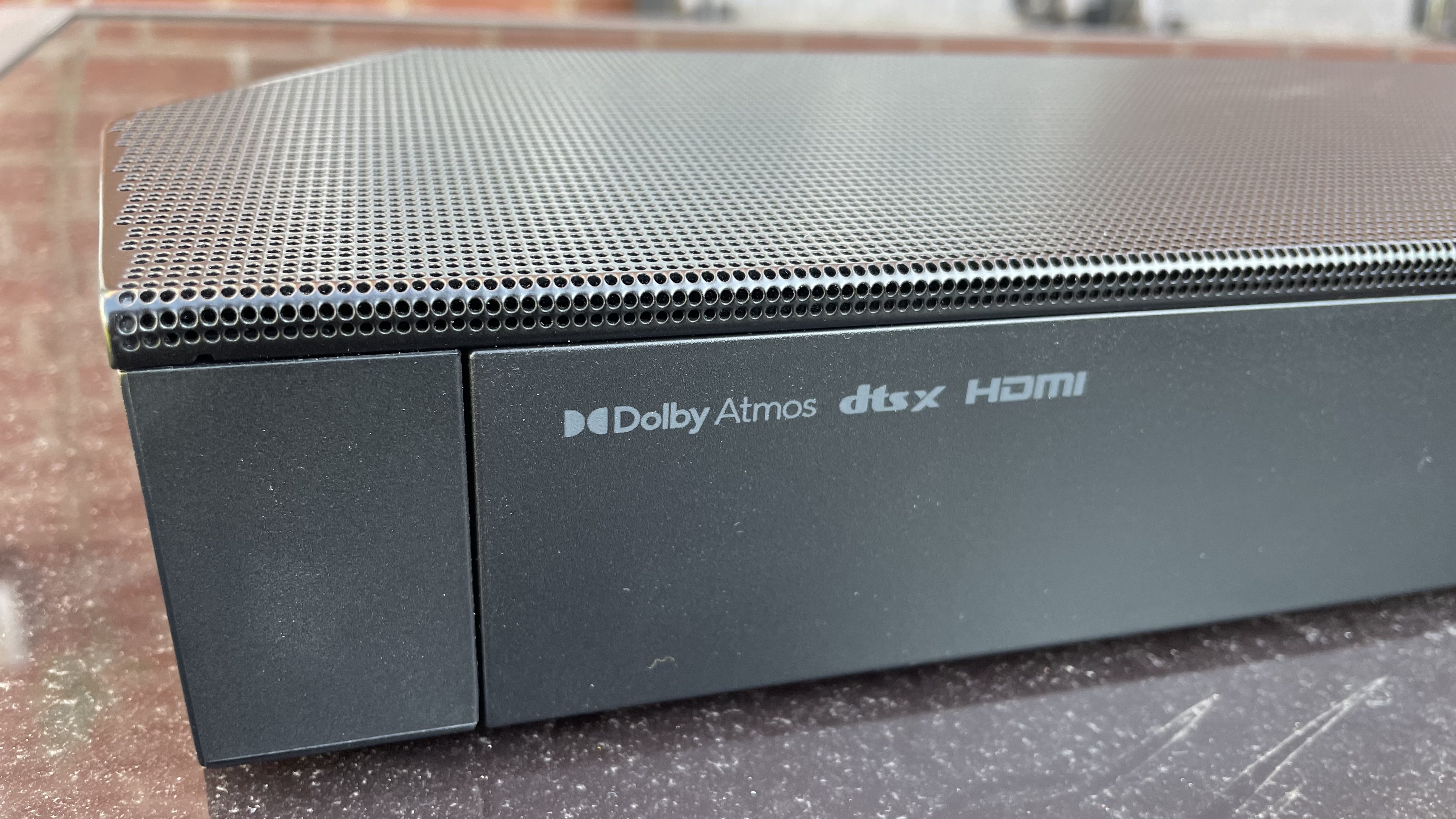
Samsung HW-Q800C review: Features
- 5.1.2 channels, 360 watts
- 4K HDR HDMI passthrough
- Some Samsung TV-specific features
The HW-Q800C’s fundamentals of a 360W power output feeding into 5.1.2 real (rather than virtual) audio channels are pretty impressive by mid-range two-piece soundbar standards. As is the fact that the optional rear speakers you can add if you want to upgrade to a full surround sound experience feature up- as well as forward-firing drivers to bolster the presence of the overhead effects that are part of Dolby Atmos soundtracks.
The included-as-standard 5.1.2 channels break down into a center speaker, front left and right speakers, side left and right speakers, two up-firing speakers built into the soundbar’s top edge, and a bass channel provided by the external wireless subwoofer. You can also effectively add more speakers to the system via Q Symphony, where the speakers in compatible Samsung TVs can intelligently join forces with those in the soundbar to deliver a bigger, more precisely detailed soundstage. The soundbar works just fine with any TV – compatible Samsung TVs just get an extra boost.
The subwoofer component sports an impressively large 8-inch driver, but lacks the acoustic lens element for smoother, wider bass dispersal that you get with the sub in Samsung’s Q990C soundbar package.
The Q800C supports an impressive array of sound formats, ranging from Dolby Atmos and DTS:X multi-channel mixes to basic surround sound, stereo, and a wide range of music file formats - including FLAC, AIFF, AAC, ALAC, WAV, WMA, OGG and MP3.
Also supported are Spotify Connect, Apple AirPlay 2 and Tidal Connect, with the soundbar’s wireless connectivity extending to Samsung’s Wireless Dolby Atmos transmission system, where the soundbar can receive Dolby Atmos signals wirelessly from compatible Samsung TVs – no HDMI required. Note, though, that the Atmos signals delivered this way will be in a compressed format, rather than the lossless True HD Atmos format you can enjoy from one of the best 4K Blu-ray players if you stick with a wired connection.
The Q800C carries Samsung’s latest Adaptive Sound system, which is designed to analyze scenes in real time and automatically present their sound in the most effective way according to their content and factors such as the volume level you have the soundbar set to. The main new innovation of this latest Adaptive Sound system is helping vocals to sound clearer when you’re listening at low volumes.
There’s more voice enhancement, too, in the shape of the Active Voice Amplifier, which can continually analyze your room’s audio environment and automatically add emphasis to vocal tracks when there’s a lot of ambient noise going on.
Gamers, meanwhile, may enjoy the Q800C’s new Game Mode Pro feature, which tweaks the audio presentation to create a more dynamic and three-dimensional soundstage to make it easier to place where specific sounds are coming from. The soundbar can even automatically switch to its Game mode when your TV does (provided that TV is a Samsung model equipped with Game Hub menu support).
Gamers should note, though, that the Q800C’s HDMI passthrough system doesn’t support 4K 120Hz video, or variable refresh rates. Such features remain rare in the soundbar world, though some of Sony's soundbars support it, including the Sony HT-A7000.
- Features score: 4.5/5
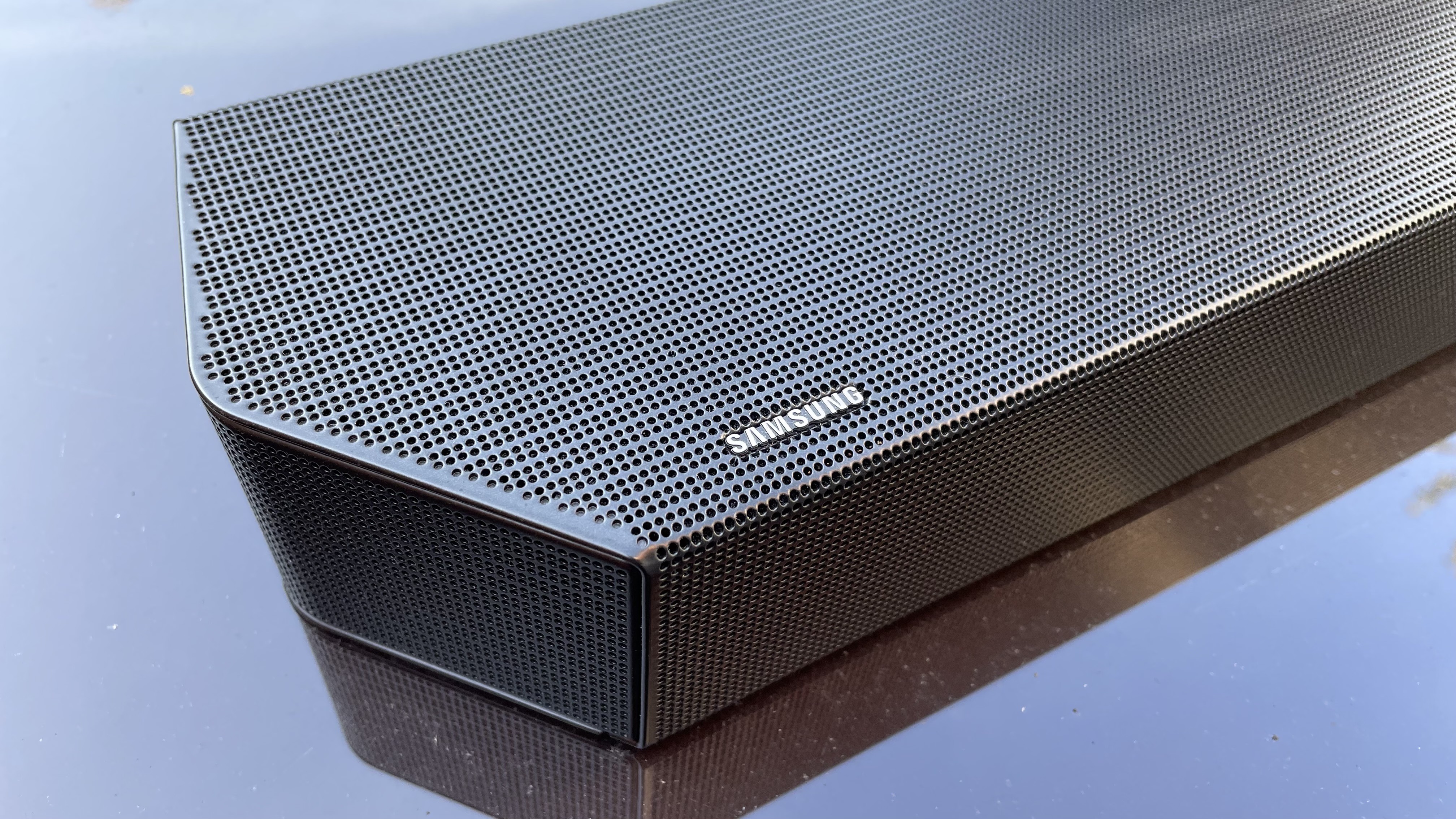
Samsung HW-Q800C: Audio performance
- Astounding power, but also a delicate touch
- Excellent clarity and detail even in busy scenes
- Great Dolby Atmos spatial effects
Having spent a lot of time with Samsung’s flagship soundbar, the Q990C, I feel compelled to kick this part of the review off by saying that I immediately missed the surround sound action provided by that flagship model’s included rear speakers. While the Q800C does, as we’ll see, do an excellent job of making all of its channels count, its sound does remain pretty resolutely in front of and, just about, to the side of you.
Of course, though, this is only to be expected with a bar-plus-subwoofer package, so it’s pretty unreasonable to criticize the Q800C on that basis. Especially given that it’s less than half the price of the Q990C. I’m just making the point that true surround-sound Dolby Atmos playback is a whole different level of experience if you can afford it.
Focusing on how the Q800C shapes up against other two-piece models with movie soundtracks, the first thing that strikes you is how powerful it is. Its sound roars forth, projecting a soundstage capable of filling even large living rooms without any of the extremities of its sound feeling over-exposed, brittle or detached from the heart of the action.
And what a heart it is. The mid-range is epic in terms of both the dynamic range it can cover and the amount of impact and bass it forces out to underpin big action-scene moments. It’s not all about aggression, though; it’s also able to ebb and swell with surprising sensitivity and smoothness to follow the demands of a good movie soundtrack.
Forceful and exuberant though the Q800C’s main soundbar component is, it never lets its meatiness get in the way of detail. On the contrary, the sensitivity of the Q800C’s 11 drivers, together with some excellent steering of the five main and two up-firing channels, produces an exceptionally busy, clean and involving sound stage in which details are both beautifully placed and well balanced. Especially with Dolby Atmos mixes. There’s no sense of specific details or effects becoming either too bright or overwhelmed by bass.
That's even though the bass features some truly epic rumbles from the Q800C’s subwoofer. The 8-inch driver reaches prodigious low frequency depths that provide action scenes with a huge sense of scale and heft. It does so, moreover, without either hanging too loosely off the bottom of the main soundbar’s lowest frequencies, or sounding flattened or compressed when the going gets really tough.
Perhaps best of all, though, is the way the subwoofer is nimble and adaptive enough to avoid sounding droney or over-dominant.
Aside from the inevitable lack of rear staging, the only remotely negative thing I can find to say about the Q800C’s movie performance is that its main bar component doesn’t sound as powerful as the Q990C system, and its bass doesn’t spread around your room quite so evenly and smoothly thanks to its lack of the Q990C’s acoustic lens attachment. But coming up short against a soundbar that costs twice as much is hardly a shock. Much more pertinently, the Q800C’s movie performance is arguably the best I’ve heard from a two-piece mid-range soundbar.

So far so good. But what about music playback, an area where Samsung soundbars have tended to struggle slightly in recent years? Happily it’s instantly obvious that the Q800C delivers a noticeable improvement over its predecessors.
Vocals, for starters, are beautifully staged, sitting perfectly at the heart of what’s an impressively widely dispersed stereo soundstage (if you’re listening in the Standard preset that leaves stereo mixes in their native form) without sounding either too bright or ever overwhelmed by the rest of the mix. Track details and layers are both produced with clarity and credibility too, joining forces to compose a tight, controlled well-timed sound stage that typically doesn’t feel forced or unbalanced.
These strengths of the Q800C’s stereo music performance hold good across most if not all types of music, too; it’s no longer just effective with pop, heavy bass or relatively ambient music.
Also much improved is the way the Q800C’s subwoofer contributes to music playback. It’s far more subtle and adaptive with its input, adding bass that feels more consistently integrated with the sound coming out of the main soundbar, and less likely to sound distractingly dominant.
The Q800C musicality improves on previous Samsung soundbar generations, too, with its Adaptive Sound mode. While this system for remixing stereo into multi-channel sound isn’t as immersive as it is with Samsung’s full surround Q990C soundbar, it still expands the Q800C’s staging of your music nicely, giving it a more room-filling, concert-hall feel while retaining the balance and "feel" of the original track more consistently than we’ve heard with previous Q800-level iterations.
One small rider I’d add to the Q800C’s improved musicality is that you need to have the subwoofer placed in front of your seating position for it to meld most effectively with the main bar. I’m not entirely certain why, but my best guess is that Samsung’s latest Space Fit pro auto-calibration algorithms can get the best handle on it.
If you’re after a soundbar as much for its music as movie capabilities, I’d also say that improved though the Q800C is, there are one or two more Hi-Fi-minded rivals out there, including the Sonos Arc and Harman Kardon Citation Multibeam 1100, that can sound more consistently deft and refined with your favorite tracks. The number of models that better the Q800C musically is far smaller than the figure posted by its predecessors – and none of that dwindling number of more musical rivals can beat the Q800C when it comes to movie soundtracks.
- Sound quality score: 5/5
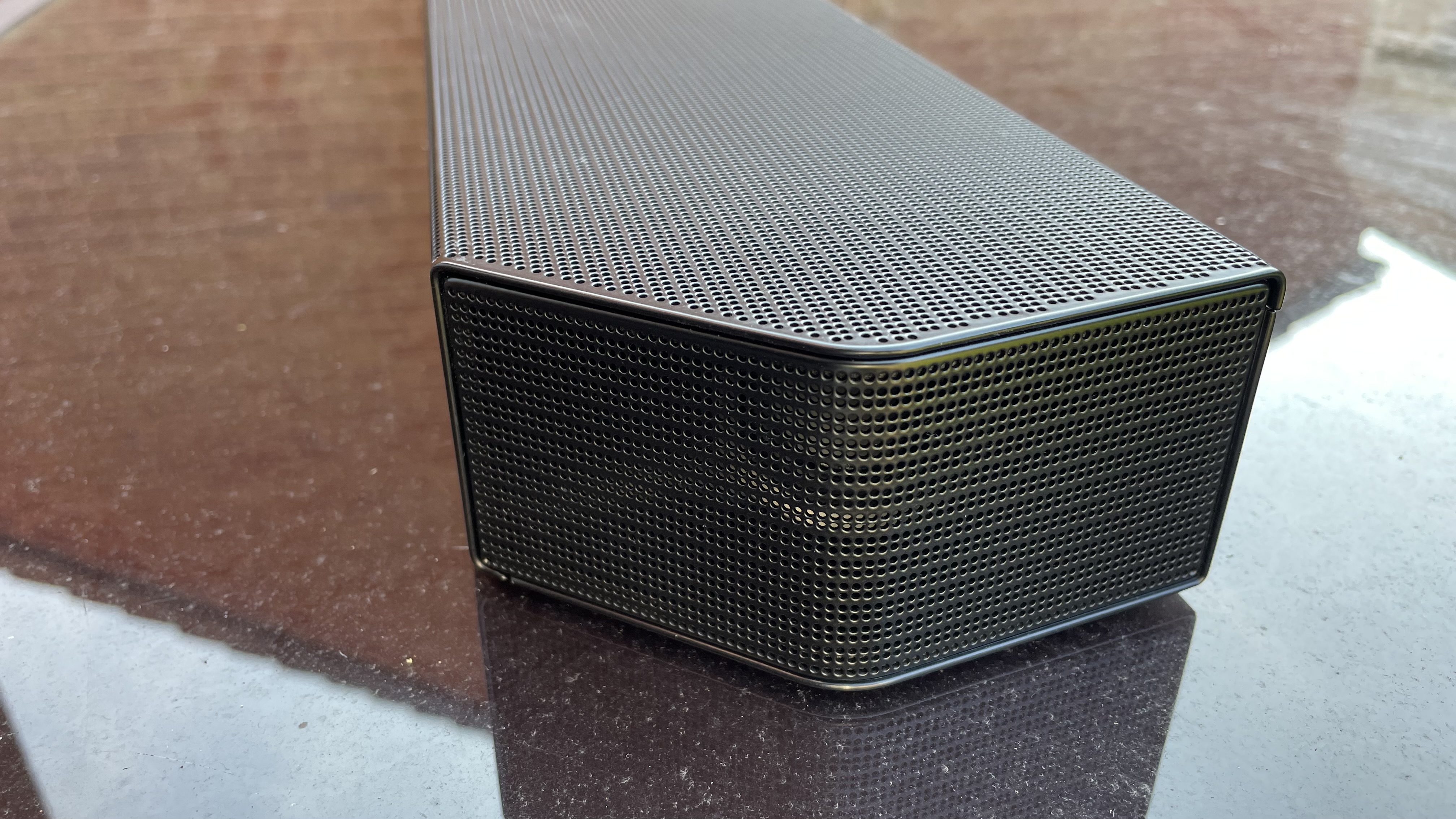
Samsung HW-Q800C review: Design
- Gray metallic plastic finish
- Angled design is on the industrial side
- Small enough for 50-inch TVs, ideal for 55-inch and up
The Samsung HW-Q800C’s main soundbar component looks a lot like its other bars, and at 1111mm / 43.4 inches wide, it's not too imposing to accommodate beneath your TV. This is a little less wide than the average 55-inch TV, and is pretty much exactly the width of a 50-inch TV, such as the Samsung Q90C. It's slightly wider than a 48-inch TV, such as the LG C3. That's what you get for not going with Samsung for everything…
The Q800C’s metallic, grilled finish looks quite attractive in an industrial kind of way, and for me is an improvement over the brief dalliance with fabric speaker covers Samsung experimented with for a couple of previous soundbar generations. The main bar and attendant subwoofer appear with a slightly grayer color scheme than the blacker finish of their 2022 predecessors. This makes the two components look a little more bland, arguably, but also less "heavy".
The main bar component features a very angular look emphasised by the sharpness of its edges, and the pointed look of each of its ends. Some might have preferred a softer look, but I kind of like the aggressiveness of it. And the angling of the end portions has a practical aspect to it, of course, as it enables the soundbar to optimize the positioning of its side-channel effects.
The subwoofer is a more prosaic affair; essentially just a large angular gray wooden box fitted with a felt-covered eight-inch driver on one side and a port to vent air pressure on its rear. Normally I’d say this subwoofer would be best placed in an inconspicuous position in your room, but as noted in the performance section, you’ll need to place the subwoofer fairly near the soundbar and your TV to get the best sound performance.
- Design score: 4/5
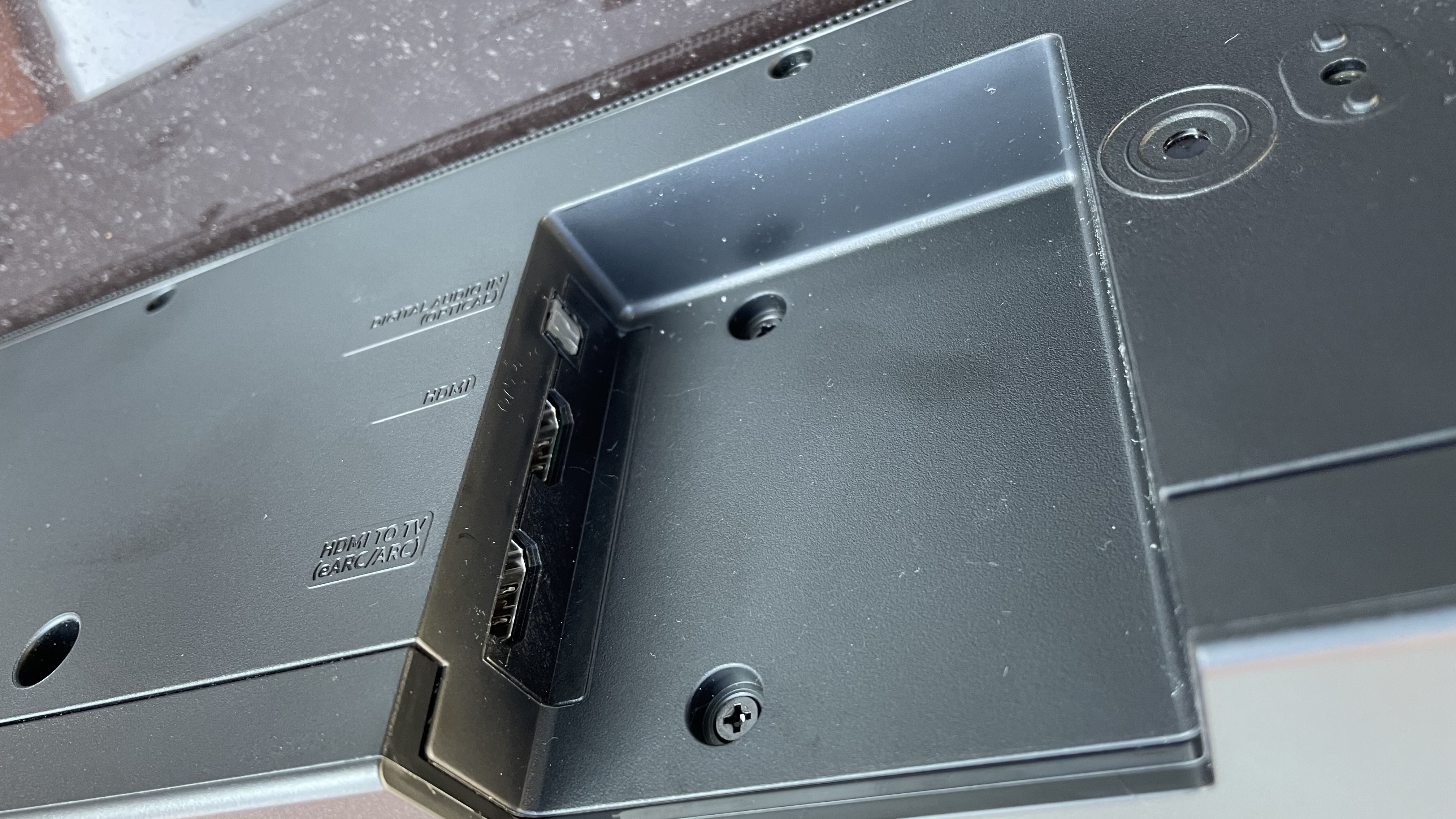
Samsung HW-Q800C review: Setup & usability
- SpaceFit room calibration is automatic
- Easy to control via app or remote
- My sub didn't pair automatically, so required a manual process
Typically Samsung soundbar packages are very easy to set up, but in the Q800C’s case things didn’t go as smoothly as usual as the subwoofer and soundbar failed to automatically detect and connect up with each other as they should. This led to a fairly complicated manual connection process. It's possible you won't have this issue, but it's certainly not what I'm used to.
Otherwise, though, setup is pretty straightforward. Especially if you install Samsung’s SmartThings app on your phone, which provides a nice menu system to support the pleasingly simple layout of the soundbar’s small, slim remote control. The soundbar also carries built-in support for the Alexa voice control system, and can additionally work with Google Assistant voice control via external listening devices.
For one last neat user-friendly trick, the Q800C can forge a connection with recent Samsung phones just by tapping the phone to the soundbar’s bodywork.
There’s a row of touch-sensitive buttons along the soundbar’s top edge should you not have your phone or remote control to hand, while an LED display on the front edge helps you keep track of basic information such as the input you’ve got selected and the sound format the soundbar is receiving.
Setup and day-to-day optimization of the Q800C is also greatly assisted by Samsung’s latest Space Fit automatic calibration system, which very effectively customizes the sound to suit your room layout, and keeps re-checking its settings regularly once you’ve first called it into action, so you don't have to keep thinking about it.
- Setup & usability: 4/5
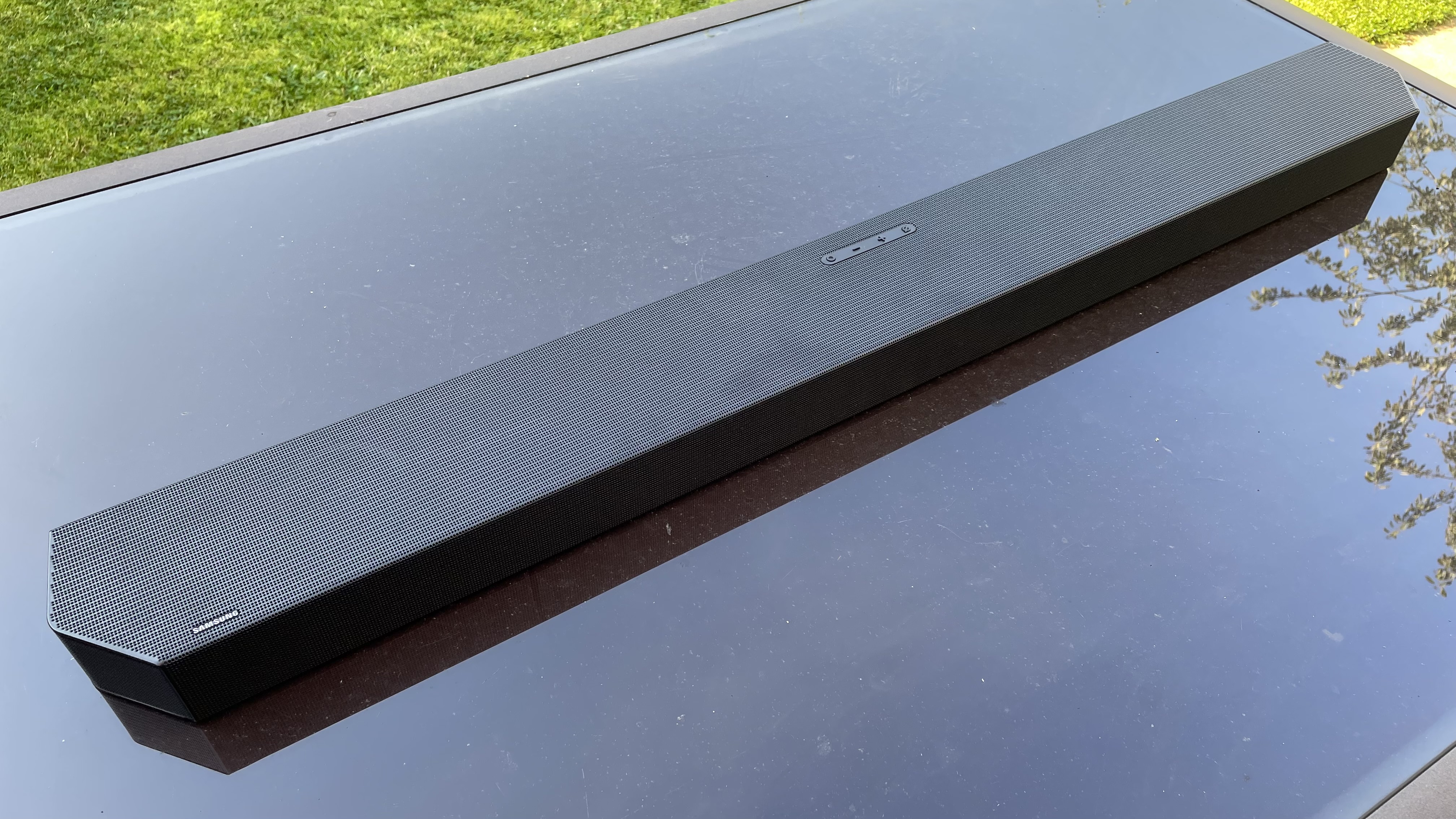
Samsung HW-Q800C review: Value
- Nothing offers richer and more powerful movie audio for the price
- For music fans, others in the same price range are a little more talented
- Rear speakers seem like a steep addition, but are well-specced
Assuming you’re in the market for a soundbar first and foremost to bring movies and TV shows to life, the Q800C represents excellent value. It undercuts its rivals, despite serving up the most powerful, impactful and accurately presented Dolby Atmos and DTS:X sound stage I’ve heard from a two-piece soundbar system.
If you want a soundbar that’s more hi-fi oriented, even though it’s much more musical than its predecessors the Q800C can be bettered by some rivals, this is true. But for movies, at this price, nothing does it better.
The optional rears are perhaps a touch expensive relative to the rest of the system - though they do add up-firing drivers as well as regular forward firers. So on a per-channel basis, maybe the wireless rear additions aren’t actually that expensive after all – but ultimately, they're optional.
- Value score: 4.5/5
Should I buy the Samsung HW-Q800C?
| Section | Notes | Score |
|---|---|---|
| Features | 4K 120Hz HDMI passthrough is basically the only thing lacking here. Extremely well-equipped. | 4.5/5 |
| Audio performance | The bigger the soundtrack, the more the Q800C laps it up. Music is improved from the previous model, too. | 5/5 |
| Design | Industrial gray won't be to everyone's taste, but I like the seriousness of it. | 4/5 |
| Setup & usability | I had a wireless sync problem, but most buyers likely won't. Outside of that, it's very slick and easy. | 4/5 |
| Value | Massive power, impressive clarity and tons of features for a price that beats basically all close rivals. | 4.5/5 |
Buy it if...
You want an exceptionally powerful and well crafted movie performance
I can’t think of any other mid-range soundbar that delivers powerful film and TV show soundtracks – especially Dolby Atmos ones – more potently than the Q800C.
You have a recent Samsung TV
Samsung’s Q Symphony and wireless Dolby Atmos transmission capabilities make the Q800C even better with a recent Samsung TV.
Don't buy it if...
You’re a music first person
While the Q800C sounds surprisingly good with music, there are one or two soundbars around at the same sort of price that sound even better. At least in stereo mode…
You need 4K 120Hz HDMI passthrough
If you have a TV with only two HDMI 2.1 ports, and both next-gen consoles you might be frustrated by the Q800C’s inability to pass 4K 120Hz signals through its HDMI ports.
Samsung HW-Q800C review: Also consider
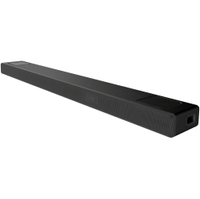
Sony HT-A5000
Price similarly to the Q800C (slightly cheaper in the UK, slightly higher in the US), this bar-only (without a sub) Sony offering isn’t as powerful or bass-rich as the Samsung with movies – but it sounds great with music, and after an update, it includes 4K 120Hz and VRR passthrough.
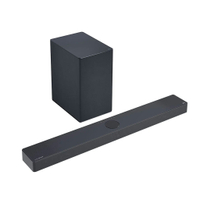
LG USC9S
LG’s new high-mid-range soundbar combines a clean, appealing design with potent sound from its two-piece design. You arguably need to use it with the LG C2 or C3 OLED TVs it was specially designed to partner, though, to get the best from it.
How I tested the Samsung HW-Q800B
- Tested over a week
- Tested with 4K Blu-rays, CDs and streamed/Bluetooth audio sources
- Reviewed in both corner and mid-wall room positions
The Samsung HW-Q800C’s main soundbar has been sat beneath 75-inch Samsung QN900B TV, which for most of the testing period has sat in a middle of the wall position rather than in a corner, to give the side-firing drivers more space to deliver their sound. The subwoofer has been tried in a variety of positions, both to the side and behind the main test seating position – though in the end it delivered the best results when placed to the side of TV, in front of my seating position.
The soundbar was also tested under the same TV moved to a corner position, to reflect the fact that this remains the most common TV position. The Q800C was not tested with the optional extra rear speakers.
The soundbar was put through its paces in each set up with a selection of Dolby Atmos and DTS:X 4K Blu-ray soundtracks, in particular It Chapter One, the 2021 version of The Invisible Man, Ready Player One and Jurassic World: Fallen Kingdom.
Compressed Atmos tracks from Netflix and Disney+ were also trialled, while on the music front I used a combination of stereo CDs and streamed files – including hi-res audio tracks – along with Tidal’s Dolby Atmos mixes, covering a range of genres including rock, pop, classical and ambient.
- Read TechRadar's review guarantee
- First reviewed September 2023
John has been writing about home entertainment technology for more than two decades - an especially impressive feat considering he still claims to only be 35 years old (yeah, right). In that time he’s reviewed hundreds if not thousands of TVs, projectors and speakers, and spent frankly far too long sitting by himself in a dark room.
